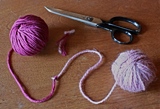 Careers in Fiber:
Careers in Fiber:Write the Great American Knitting Novel
|
If everybody has a novel inside of them, does this mean that our novels must be about knitting? Not necessarily. But if yours is, here are some words of advice on getting published. Survey Your Market As with magazines, your first step is to survey the market and determine which publisher would be most appropriate for the theme of your book. But also keep in mind that publishers may be hesitant to sign a new book that's too similar to something they've already published. For example, if your idea is to travel across America and profile various fiber artists, you may not want to pitch Interweave Press, publishers of "Knitting in America." If your idea is to cover fiber artists in other countries, however, Interweave would be a good candidate. Finding Your Editor Look at this publisher's other books. Keep in mind that some publishers will favor authors that they've already published in other mediums, such as XRX Books with Knitter's Magazine, or Interweave Press with Interweave Knits. Don't let this stop you from trying, but do keep it in mind as you develop your proposal. Read the copyright, acknowledgement, and introduction pages. Here you'll find out who helped bring the book to fruition behind the scenes. You'll often see a project editor, technical editor, or even copyeditor identified. If you keep a list of these names, you'll begin to see a pattern of which editors focus on which types of books. From here you can identify the most appropriate editor to approach with your book idea. Depending on the publisher, you may first be directed to an acquisitions editor. This person's sole job is to stay on top of trends and anticipate new hot spots, sort through proposals, and bring in new contracts. From here the book can be handed off to a developmental editor (if extensive development is necessary) or straight to a project editor who will work with you and coordinate with the design, production, and marketing team to bring the book to market. Other Publishers The increased popularity of knitting can work to your advantage. New publishers may be more interested in exploring the market. For example, Lily Chin's new book, "Urban Knitting," was published by knitting outsider Penguin Putnam. Don't be afraid to cast your net wider if you believe you have a chance. A Winning Pitch Unless you're already a well-known, successful writer, you'll have to do your homework before submitting your book proposal. Consider it the publisher's equivalent of a mortgage application. You need to convince them that their investment will pay off. List your pertinent experience and background. This obviously includes your knitting-related credentials, but also any other experience you believe would play into your ability to write a successful book. Essentially, you want to demonstrate why you are more qualified than anyone else to write this book. The Competitive Analysis Your book proposal should also demonstrate that you understand the current knitting market. Compile a list of existing titles that are most similar to your topic.
Doing It Yourself What if you have a brilliant idea and don't want to go through all these hoops? You can always publish the book yourself. It's a harder road, with its own pros and cons. Although some self-published titles never get beyond a small readership, others -- such as Cat Bordi's Socks Soar on Two Circular Needles, become national sellers. Benefits of Self-Publishing When you choose to publish a book yourself -- whether it's knitting patterns, stories, profiles, or techniques -- you stand to gain all the profit, not just a small percentage. You have full control over every element of the book, from content to design. You're not restricted by a publisher's editorial mandates. Whereas publishers normally only release a limited number of copies, after which the book goes out of print, you can keep the book in print as long as there's a demand. Self-Publishing: Drawbacks Each benefit comes hand in hand with a drawback. Yes, you stand to gain all the profit. But you also must absorb all the costs of putting the book into production. Just as you can gain every penny, you can also lose it. You must be comfortable wearing many hats: author, editor, designer, publisher, distributor, and promoter, to name just a few. You won't have any of the vast resources available to you that book publishers provide. Final Advice One of the biggest mistakes people make when self-publishing is to assume they can do it all themselves. It's essential that you find yourself an editor, even if it's simply a friend whose opinion and intelligence you respect. Everybody needs an editor. We all miss things, and nothing beats the insight and fresh perspective provided by a new pair of eyes. Some people will share their entire manuscript with numerous people, though too much feedback can dilute your original editorial vision. Also, consider procuring professional graphics or photography if you're not comfortable doing this yourself. I hate to say this, but looks do matter. Your words could be brilliant, but without the draw of a good cover, you may never get people to look inside. Knitting-Related Publishers On-Demand Publishing Services (Self-Publishing) Additional Resources for Writers |




